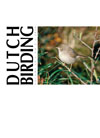Dutch Birding volume 30 (2008) no 2

30 years Dutch Birding, part 2: 1984-88
This paper describes the second five-year period of Dutch Birding and the Dutch Birding Association (DBA). In this period, many ‘new’ birders became active in the journal’s editorial team or as member of the board. The Dutch rarities committee (CDNA) was virtually transformed by a ‘new generation’ of Dutch Birding members taking over the workload. In 1987, this situation was formalized when the CDNA became a joint committee of the Netherlands Ornithologists’ Union (NOU) and DBA. A milestone in this period was the completion of the first phase of the revision of the Dutch list. This resulted in the removal of (more than) 24 species. Another milestone was the beginning of the Dutch Birding birdline in May 1987, a simple answering phone in the first years, making bird news accessible for any interested birder and not only for those connected through the ‘grapevine’. During this period, also the first colour photographs (in 1986) and the first sonagrams were published in Dutch Birding. A number of key identification papers in these years is mentioned, including several by Killian Mullarney and Hadoram Shirihai. Four Inter¬national Bird Identification Meetings greatly influenced the thinking about bird identification and resulted in agreements about terminology of plumages and moult. In 1987, journals with similar contents were founded in England (Twitching, after a year renamed as Birding World) and Germany (Limicola). Meanwhile, telescopes had become part of the average birder’s outfit. All these developments together may explain why the number of rarities gradually increased and, in 1984-88, 20 species and a few subspecies were added to the Dutch list (compared with 16 species in 1979-83). Chronologically, these were Greater Sand Plover Charadrius leschenaultii of the leschenaultii/crassirostris subspecies group, Citrine Wagtail Motacilla citreola and Spectacled Warbler Sylvia conspicillata in 1984; Bonaparte’s Gull Chroicocephalus philadelphia, Red-eyed Vireo Vireo olivaceus, ‘isabelline shrike’ Lanius isabellinus/phoenicuroides, Siberian Chiffchaff Phylloscopus collybita tristis and Ross’s Goose Anser rossii in 1985; Alpine Accentor Prunella collaris, Ring-billed Gull Larus delawarensis, Forster’s Tern Sterna forsteri, White-throated Robin Irania gutturalis and Black-faced Bunting Emberiza spodocephala in 1986; Ivory Gull Pagophila eburnea, Moltoni’s Subalpine Warbler S cantillans moltonii, Red-necked Stint Calidris ruficollis, Franklin’s Gull L pipixcan, Baltimore Oriole Icterus galbula and Olive-backed Pipit Anthus hodgsoni in 1987; and Black-headed Wagtail M feldegg, Pied Wheatear Oenanthe pleschanka, Caspian Gull L cachinnans, Northern Mockingbird Mimus polyglottos and Asian Desert Warbler S nana in 1988. Of these, Black-headed Wagtail, Spectacled Warbler, Northern Mockingbird and Baltimore Oriole have not been recorded since. Caspian Gull, on the other hand, has become so regular that, already more than 10 years ago, it was removed from the list of species considered by the CDNA. Other vagrants seen in this period which have not been twitchable since include Steppe Eagle Aquila nipalensis, Cream-coloured Courser Cursorius cursor and Eyebrowed Thrush Turdus obscurus. The organized birding week(s) on Wadden Sea islands in autumn moved from Terschelling, Friesland, to the more easily accessible island of Texel, Noord-Holland, being quite success¬ful in most though not all years. At the end of 1988, the Dutch ranking was headed by Edward van IJzendoorn and Gerard Steinhaus with 362 species, followed by Klaas Eigenhuis and Gerald Oreel (361) and Eus van den Burg and Jowi de Roever (359). The highest year totals were 281, reached by Eric Bos in 1982 and Klaas Eigenhuis in 1985.G J (Hans) ter Haar, Hollandse Hout 127, 8244 GD Lelystad, Nederland (hterhaar
 planet.nl)
planet.nl)
terug






